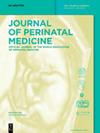Sensitivity of antenatal ultrasound in diagnosing posterior placenta accreta spectrum disorders
IF 1.7
4区 医学
Q3 OBSTETRICS & GYNECOLOGY
引用次数: 0
Abstract
Objectives Optimal management of placenta accreta spectrum (PAS) requires antenatal diagnosis. We sought to evaluate the sensitivity of ultrasound findings suggestive of PAS in detecting posterior PAS. Methods Cohort study of patients with posterior placentation and pathology-confirmed PAS from 2011 to 2020 at a tertiary center. Patients were excluded if ultrasound images were unavailable. Ultrasounds were reviewed for presence of lacunae, hypervascularity, myometrial thinning, loss of the hypoechoic zone, bridging vessels, abnormal uterine serosa–bladder interface, placental bulge, placental extension into/beyond the myometrium, and an exophytic mass. Risk factors, postpartum outcomes, and ultrasound findings were compared by antepartum suspicion for PAS. Sensitivity was calculated for each ultrasound finding. Results Thirty-three patients were included. PAS was not suspected antenatally in 70 % (23/33). Patients with unsuspected PAS were more likely to be non-Hispanic, have产前超声诊断后置胎盘频谱紊乱的敏感性
目的 胎盘早剥谱(PAS)的最佳处理需要产前诊断。我们试图评估提示 PAS 的超声检查结果对检测后置胎盘的敏感性。方法 对一家三级中心 2011 年至 2020 年期间患有后置胎盘并经病理学证实为 PAS 的患者进行队列研究。如果无法获得超声图像,则排除患者。对超声图像进行审查,以确定是否存在裂隙、血管过多、子宫肌层变薄、低回声区消失、桥接血管、子宫浆膜-膀胱界面异常、胎盘隆起、胎盘延伸至/超出子宫肌层以及外生肿块。根据产前对 PAS 的怀疑程度,比较了风险因素、产后结局和超声检查结果。计算了每种超声检查结果的敏感性。结果 共纳入 33 名患者。70%的患者(23/33)在产前未怀疑过 PAS。未怀疑 PAS 的患者多为非西班牙裔、体外受精、无剖宫产史、无前置胎盘、妊娠晚期分娩。未怀疑 PAS 的侵犯深度和估计失血量较少,但各组间的子宫切除术没有差异。产前未怀疑有前置胎盘者超声检查结果较少出现:裂隙 17.4% 对 100%(p<0.001),血管过多 8.7% 对 80%(p<0.001),子宫肌层变薄 4.4% 对 70%(p<0.001),胎盘桥接血管 0% 对 60%(p<0.001)。所有结果的灵敏度都很低(0-42.4%)。结论 由于在后置胎盘的情况下典型超声检查结果的敏感性较低,因此在产前发现后置胎盘的可能性较低。需要进一步研究以更好地确定后置胎盘的可靠标记。
本文章由计算机程序翻译,如有差异,请以英文原文为准。
求助全文
约1分钟内获得全文
求助全文
来源期刊

Journal of Perinatal Medicine
医学-妇产科学
CiteScore
4.40
自引率
8.30%
发文量
183
审稿时长
4-8 weeks
期刊介绍:
The Journal of Perinatal Medicine (JPM) is a truly international forum covering the entire field of perinatal medicine. It is an essential news source for all those obstetricians, neonatologists, perinatologists and allied health professionals who wish to keep abreast of progress in perinatal and related research. Ahead-of-print publishing ensures fastest possible knowledge transfer. The Journal provides statements on themes of topical interest as well as information and different views on controversial topics. It also informs about the academic, organisational and political aims and objectives of the World Association of Perinatal Medicine.
 求助内容:
求助内容: 应助结果提醒方式:
应助结果提醒方式:


